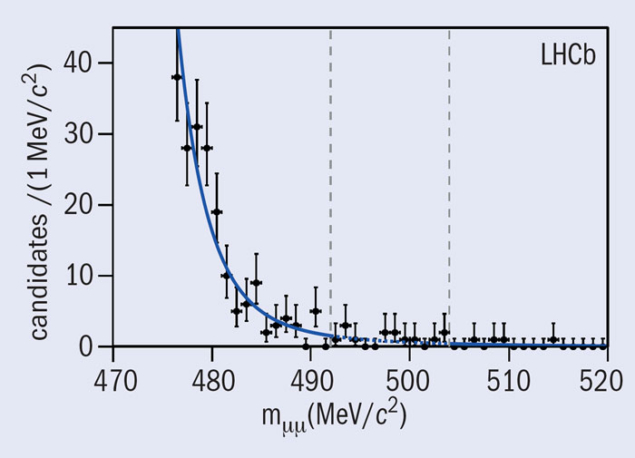The LHCb experiment was originally conceived of to study particles containing the beauty-flavoured b quark. However, there are many other possibilities for interesting measurements that exploit the unique forward acceptance of the detector. For example, the physics programme has already been extended to include the study of particles containing charm quarks, as well as electroweak physics. Now, a new result from LHCb on a search for a rare kaon-decay has further increased the breadth of the experiment’s physics goals.
This search is for the decay K0S→μ+μ–, which is predicted to be greatly suppressed in the Standard Model. The branching ratio is expected to be 5 × 10–12, while the current experimental upper limit (dating from 1973) is 3.2 × 10–7 at 90% confidence level (CL). Although the dimuon decay of the K0L has been observed, with a branching fraction of the order of 10–8, searches for the counterpart decay of the K0S meson are well motivated because such decays can be mediated in independent ways to the K0L decay.

The analysis is based on the 1.0 fb–1 of data collected by LHCb in 2011. To suppress the background most efficiently, it involves several techniques that were originally developed for the search for B0S → μ+μ–, for which LHCb has set the best limit in the world. The analysis also benefits from knowledge of K0S production and reconstruction that has been developed in several previous measurements (including LHCb’s first published paper, on the production of K0S mesons in 900 GeV proton–proton collisions).
To extract an upper limit on the branching fraction, the yield is normalized relative to that in the copious K0S→π+π– decay mode. The 90% CL upper limit on the branching ratio B(K0S→μ+μ–) is determined to be less than 9 × 10–9, a factor of 30 improvement over the previous most restrictive limit. As the figure shows, no significant evidence of the decay is seen.
Although the new limit is still three orders of magnitude above the Standard Model prediction, it starts to approach the level where new physics effects might begin to appear. Moreover, the data collected by LHCb in 2012 already exceed the sample from 2011 and by the end of the year the total data set should have more than trebled. The collaboration is continuing to search for ways to broaden its physics reach further to make the best use of this unprecedented amount of data and to tune the trigger algorithms for future data-taking and for the LHCb upgrade.
Further reading
LHCb-PAPER-2012–023, submitted to JHEP.





